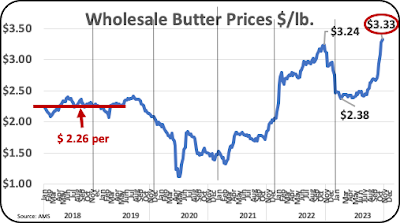 |
| Chart I - Wholesale Weekly Butter Prices |
 |
| Chart II - Wholesale Weekly Cheese Prices |
 |
| Chart III - Cheese Prices Over the Last 10 Years |
 |
| Chart IV - Wholesale Dry Whey Prices |
 |
| Chart I - Wholesale Weekly Butter Prices |
 |
| Chart II - Wholesale Weekly Cheese Prices |
 |
| Chart III - Cheese Prices Over the Last 10 Years |
 |
| Chart IV - Wholesale Dry Whey Prices |
The new buzzword for the dairy industry is sustainability. The USDA defines sustainability as "Sustainable agriculture is farming in such a ways to protect the environment, aid and export natural resources and to make the best use of nonrenewable resources." Dairy needs to provide food that is desirable, healthy, and affordable. U.S. dairies are doing just that. Today's dairy products primarily need healthy components, like butterfat and protein. When the amount of these components in milk increases, the needed components can be supplied with fewer cows and at lower cost. This post will cover the trends that accomplish these requirements.
The data used in this post is Federal Order averages. Individual producers do achieve significantly higher levels of components.
BUTTERFAT
Chart I shows the trends in butterfat production as a percent of milk. The increases are steady and ongoing. How long can these trends continue to grow? The gains are clearly not slowing down. From the beginning on 2018 to the most current month of August 2023, butterfat in milk has increased from 3.83% to 4.09% (Chart I).
 |
| Chart I - Average percent of Butterfat in Milk |
The increases in butterfat volume are growing by over 1% annually (Chart II). A producer with 3000 cows with each producing 30,000 pounds of milk annually would get 36,000 more pounds of butterfat than the prior year.
90,000,000 pounds of milk with 4% butterfat and increasing butterfat by 1% annually = 36,000 more pounds of butterfat annually
The increase builds annually. If at 4% butterfat, a one percent increase would make the butterfat percent go to 4.04% and the next year to 4.08% etc. Using protein's current price of $3.13 per pound, the producer would get $113,000 more revenue than the prior year with no additional cows.
 |
| Chart II - Annual Percent Growth in Butterfat |
 |
| Table I - Butterfat Percent by Federal Order |
 |
| Chart III - Annal Percent of Protein in Milk |
 |
| Chart IV - Annual Percent Growth in Protein |
Protein is paid for in the seven Federal Orders paid on the Class and Component system. As shown in Table II, the .23% spread between the seven Orders is relatively small, compared to the .54% spread for butterfat shown in Table I.
 |
| Table II - Protein Percent by Federal Order |
 |
| Chart V - Average Somatic Cell Count |
SUMMARY
The gains in volume for butterfat and protein are a tremendous improvement for both sustainability and for improved producer revenue. There are various technics for improving butterfat. There is one main improvement for increasing milk protein and that is amino acid balancing cf feed. Amino acid balancing also improves butterfat volume creating a combined return on the investment for feeding the proper level of needed amino acids. The technology has been practiced for a long-time and is well proven.
Producer milk prices have fallen tremendously in 2023. The big question is "When will prices improve to make milk production profitable again?" The reasons for the fall in prices was covered in a recent post. This post will look to the future to see when and by how much producer milk prices may increase. The volatility during the span of data in this review is tremendous. Three-year trends and quarterly price changes will be reviewed in this post.
Butterfat prices have been a big contributor to the producer milk price and will be reviewed first. Butterfat values increased tremendously in 2021 and most of 2022. Then butter consumption declined (see the September 10 post) and the Butterfat price declined by 25% in three months. Recently producer butterfat prices have started increasing and may reclaim the higher prices in the fourth quarter of 2023.
 |
| Chart I - Butterfat Prices for 2022 through 2023 |
 |
| Table I - Quarterly Butter Prices for 2021 Through YTD 2023 |
Protein prices have dropped continuously in 2021 to 2023. This is partially caused by increasing retail butter price. From the highs in May 2022 to the lows in July 2023, the value of milk protein decreased by 70%. However, from July to September 2023, prices nearly doubled (Chart II). The question now is "Will the future months continue to increase?", or will they follow the overall decline of the last three years?
 |
| Chart II - Milk Protein Prices for 2022 through 2023 |
Table II compares the quarter-by-quarter milk protein prices from the prior year. Cheese prices, which largely control the protein prices are relatively stable with the prior year. As butterfat prices increase, milk protein prices decline. Below is the simplified formula for pricing milk protein.
Milk Protein = 3.22 x AMS cheese Price - 1.05 x AMS butterfat price - $5.65
The current milk protein prices indicate no further decreases or increases with pricing stability for the near future.
 |
| Table II - Quarterly Protein Prices for 2021 Through YTD.2023 |
 |
| Chart III - Nonfat Dry Milk Prices for 2022 through 2023 |
 |
| Table III - Quarterly NDM Prices for 2021 Through YTD 2023 |